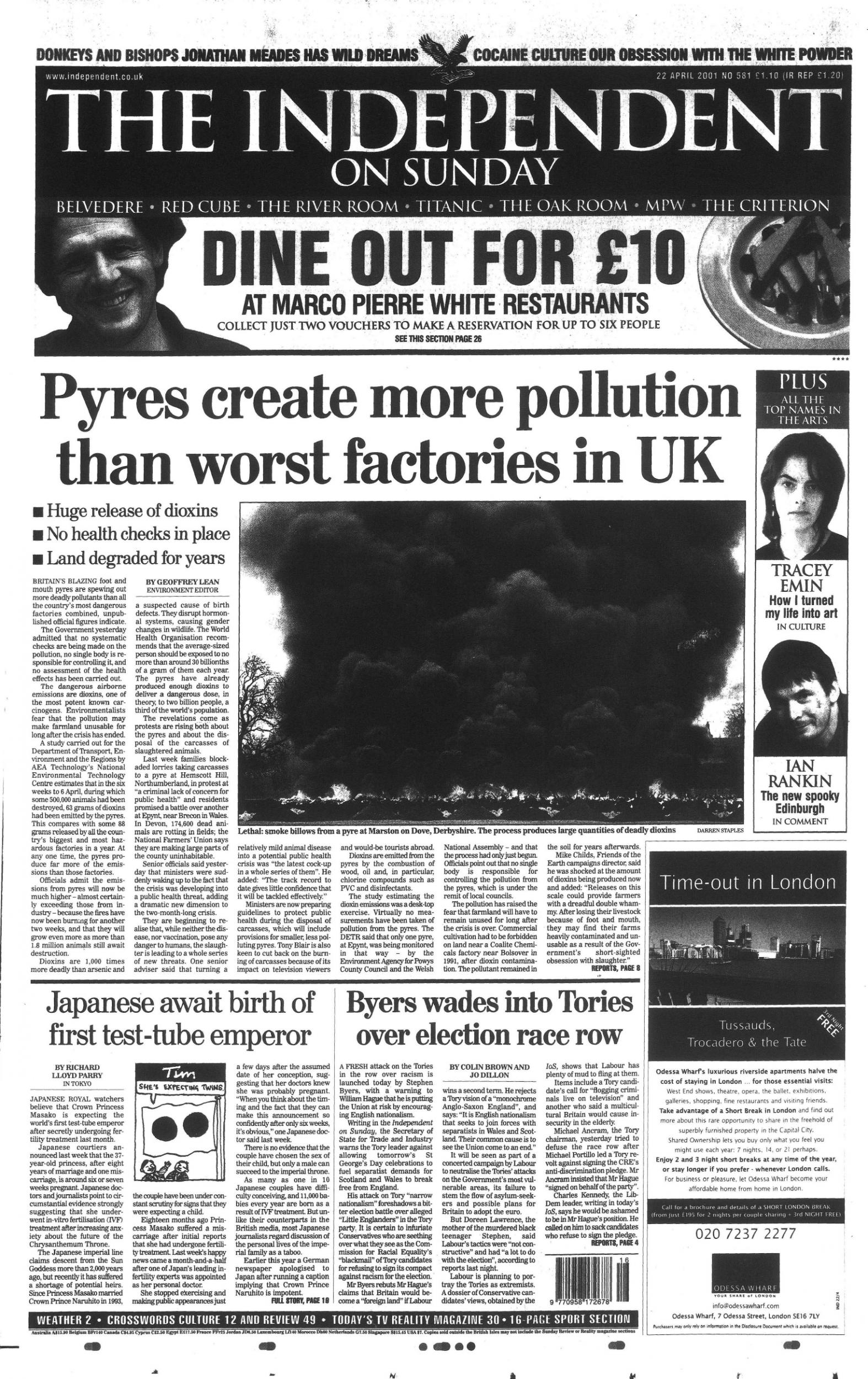Foot-and-mouth pyres created more pollution than all the factories in Britain
A government study in April 2001 revealing the scale of emissions raised the fear that farmland would have to remain unused for long after the crisis was over, reports Geoffrey Lean

Britain’s blazing foot-and-mouth pyres are spewing out more deadly pollutants than all the country’s factories combined, unpublished official figures indicate.
The government yesterday admitted that no systematic checks are being made on the pollution, no single body is responsible for controlling it, and no assessment of the health effects have been carried out.
The dangerous airborne emissions are dioxins, one of the most potent known carcinogens. Environmentalists fear that the pollution may make farmland unusable for long after the crisis has ended.
A study carried out for the Department of Transport, Environment and the Regions by AEA Technology’s National Environmental Technology Centre Estimates that in the six weeks to 6 April, during which some 500,000 animals had been destroyed, 63 grams of dioxins had been emitted by the pyres. This compares with some 88 grams released by all the country’s biggest factories in a year. At any one time, the pyres produce far more of the emissions than those factories.
Officials admit the emissions from pyres will now be much higher – almost certainly exceeding those from industry – because the fires have now been burning for another two weeks, and that they will grow even more as more than 1.8 million animals still await destruction.
Dioxins are 1,000 times more deadly than arsenic and a suspected cause of birth defects. They disrupt hormonal systems, causing gender changes in wildlife. The World Health Organisation recommends that the average-sized person should be exposed to no more than around 30 billionths of a gram of them each year.
The pyres have already produced enough dioxins to deliver a dangerous dose, in theory, to two billion people, a third of the world’s population.
Six months after the outbreak, farming life begins again. Read the final part here
The revelations come as protests are rising both about the pyres and about the disposal of the carcasses of slaughtered animals.
Last week families blockaded lorries taking carcasses to a pyre at Hemscott Hill, Northumberland, in protest at “a criminal lack of concern for public health” and residents promised a battle over another at Epynt, near Brecon in Wales. In Devon, 174,600 dead animals are rotting in fields; the National Farmers’ Union says that they are making large parts of the county “uninhabitable”.

Senior officials said yesterday that ministers were suddenly “waking up” to the fact that the crisis was developing into a public health threat, adding a dramatic new dimension to the two-month-long crisis.
They are beginning to realise that, while neither the disease, nor vaccination, pose any dangers to humans, the slaughter is leading to a whole series of new threats. One senior adviser said that turning a relatively mild animal disease into a public health crisis was “the latest cockup in a whole series of them”. He added: “The track record to date gives little confidence that it will be tackled effectively.”
Ministers are now preparing guidelines to protect public health during the disposal of carcasses, which will include provisions for smaller, less polluting pyres. Tony Blair is also keen to cut back on the burning of carcasses because of its impact on television viewers and would-be tourists abroad.
Dioxins are emitted from the pyres by the combustion of wood, oil and, in particular, chlorine compounds such as PVC and disinfectants.
The study estimating the dioxin emissions was a desk-top exercise. Virtually no measurements have been taken of pollution from the pyres. The DETR said that only one pyre, the one at Epynt, was being monitored in this way – by the Environment Agency for Powys County Council and the Welsh National Assembly – and that the process had only just begun. Officials point out that no single body is responsible for controlling the pollution from the pyres, which is under the remit of local councils.
The pollution has raised the fear that farmland will have to remain unused for long after the crisis is over. Commercial cultivation had to be forbidden on land near a Coalite Chemicals factory near Bolsover in 1991, after dioxin contamination. The pollutant remained in the soil for years afterwards.
Mike Childs, Friends of the Earth campaigns director, said he was shocked at the amount of dioxins being produced now and added: “Releases on this scale could provide farmers with a dreadful double whammy. After losing their livestock because of foot and mouth, they may find their farms heavily contaminated and unusable as a result of the government’s short-sighted obsession with slaughter.”
This article first appeared on The Independent on 22 April 2001
Join our commenting forum
Join thought-provoking conversations, follow other Independent readers and see their replies
Comments